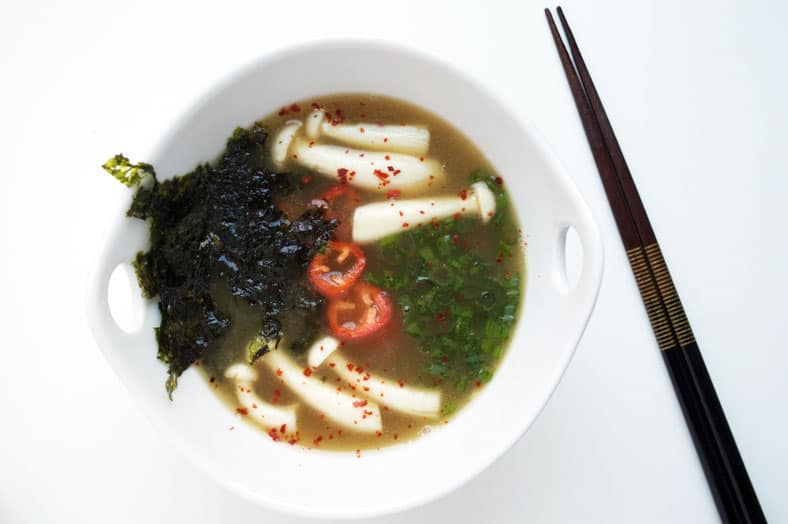Tteokguk, or Korean rice cake soup, is at the center of the Korean celebration of the lunar new year, Seollal. Although the origins of the recipe are unknown, it began to make appearances in Korean literature in the 19th century. Since then, tteokguk has grown in popularity, and is now consumed throughout the year.
While we can’t dive too deeply into the origin of this rice cake soup, an exploration of the rich and intricate tapestry of tradition that embodies this soup is a fascinating journey upon which we can embark.

Seollal, Korean New Year Dishes – Sechan, and Tteokguk
Much like the Chinese do, Koreans also celebrate the lunar new year.
Historically, Korea, Japan, and China all used the same lunar calendar to track the passage of time. Each country used the lunar calendar exclusively until the 19th century, when all three gradually transitioned to the Gregorian calendar.
In Korea, King Gojong ordered the use of the solar calendar in 1895, but the lunar calendar is still very much in use and Koreans celebrate the major lunar holidays throughout the year.
If you like this recipe….
You might want to check out how the Vietnamese celebrate new year with their Banh Chung Rice Cakes! Don’t fear the banana leaves, sticky rice cakes are very yummy to eat, and fun to make! Or, you might appreciate making a steak pie with dark ale and puff pastry – which is how the Scottish celebrate their new years!
Feeling adventurous, browse all our recipes here.
Seollal: the Korean New Year
Seollal marks the beginning of a new lunar year in Korea. It is a three day festival, the main celebration for which is held on the second of the three days.
The first known historical reference to Seollal is in a seventh century book titled “The Book of Sui.” In the book, it describes how the people of the Silla kingdom salute the sun and the moon on the first day of the new year.
The Seollal festival is the most prominent festival in Korean custom. Participants dress in their newest and best clothes as they gather with their families to practice the many rites and traditions that embody the holiday.
Ancestral worship lies at the heart of Seollal. Families gather at the home of the eldest male relative to prepare large quantities of food, that is then offered to the family’s ancestors before being consumed by the family. Traditionally, the women prepare the food and the men perform the rite of offering the food to the family’s ancestors.
This offering ceremony is called the Seolcharye, however, the offering of rice cake soup is specifically called a Tteokguk Charye. Families make offerings to the past four generations of ancestors.
As families celebrate the beginning of the new year by making offerings to their ancestors, they are informing their ancestors of the passage of time. This rite kicks off the elaborate traditions of the holiday that fuses a respect for the past with an appreciation for the future.
Following the Seolcharye, family members conduct exchange Sebae, new year’s blessings, with one another. Younger family members bow to elder family members and receive a blessing in return. Young children even receive small gifts of money from their elder family members!
After the Sebae, all of the family members consume the prepared foods (in which tteokguk is definitely included).
One of the most delightful aspects of Seollal is sharing wishes of good fortune with friends and loved ones. Wishes are often expressed in the past tense, in an effort to express an earnest desire for the wish to come true.
For example, one might say, “I heard that you were married this year.” Have you ever heard of a more beautiful and sincere way to express well wishes? In the spirit of this tradition, we heard that your year was filled with good fortune and delicious meals.
Sechan: Korean New Year Dishes
If there’s one thing to keep in mind about the Korean Lunar New Year celebration, it’s that there’s a lot of Sechan, or special dishes specifically for the New Year.
There are a wide variety of Sechan prepared to celebrate the lunar new year. In a 2008 study that, among other things, counted the number of traditional Korean dishes, it was learned that there are 5 main dishes, 35 side dishes, and dozens of other smaller dishes and desserts prepared for the new year.
The many smaller dishes that constitute Sechan are often mailed or delivered to friends and distant relatives. Truly, the Koreans excel at spreading well wishes and tasty treats to welcome the new year.
Tteokguk and Aging One Year
Rice cake soup is the main dish on Korean New Year. It has a significance not unlike the turkey for Americans during Thanksgiving. During Seollal, tteokguk replaces cooked rice as the main dish of the meal.
In a nineteenth century book about Korean festivals, “Dongguk Sesigi,” this rice cake soup appears under a variety of names. One of these names is cheomsebyeong, which means aging rice flakes, because it is believed that one can only age one year after having consumed a bowl of Tteokguk.
In Korean, asking a person how many bowls of rice cake soup they have eaten is the equivalent of asking a person their age. Because the soup is traditionally only eaten on the Lunar New Year, a person will only have eaten as many bowls as they are years old.
It is said that on Seollal, some young people try to sneakily eat multiple bowls of soup in an effort to age more than one year at a time! We don’t know about you, but some years we would have liked to skip our bowl of rice cake soup and stay a bit younger!
A Cloudy Origin for a Clear Soup
Tteokguk is about more than just nourishment for the body. It nourishes connections to one’s family, both living and ancestral.
Unfortunately, the origin of tteokguk is unknown. What little is known of this rice cake soup is that the stock was historically made with pheasant. It is believed that pheasant is the traditional ingredient because pheasants became widely available when falconry was introduced to the aristocracy on the Korean peninsula by the Yuan Dynasty circa the thirteenth century.
Food made with the meat of animals hunted by falcons, mainly pheasants, were considered a luxury at the time. It is believed that this is why pheasant was used to make tteokguk, because serving it was a special occasion due to the luxury obtaining a bird killed through falconry.
On the most important holiday of the year, those who could use pheasant proudly served it to their ancestors and family member. Those who could not afford pheasant used chicken as a substitute for the stock.
Now, many Koreans use beef to make the stock for their rice cake soup, though (as we’ll soon see) the tteokguk is highly adaptable and can be made from a variety of ingredients to suit different dietary needs.
Saehae bog many-i bad-euseyo! Happy new year!
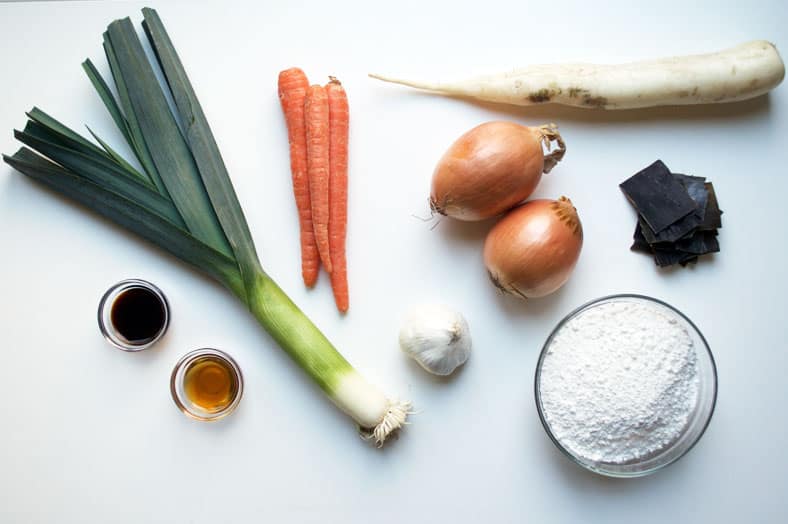
About the Recipe
When it comes to preparing tteokguk, there are two key components to the recipe itself: the broth and the rice cakes.
Since it’s the most straightforward, we’ll start with the broth. You’ll see later on that we tried our hand at an adjusted vegan version, but tteokguk broth is most commonly built with a base flavor from either beef or myeolchi, special Korean salted and lightly fermented anchovies. In the case of using myeolchi, you’d start your broth by soaking the anchovies in cold water for several hours before bringing it over heat, but that’s a step you don’t need with beef.

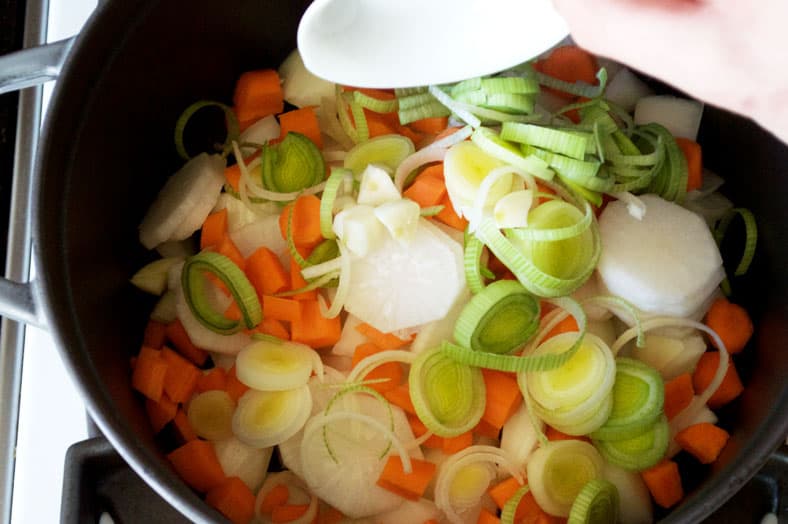
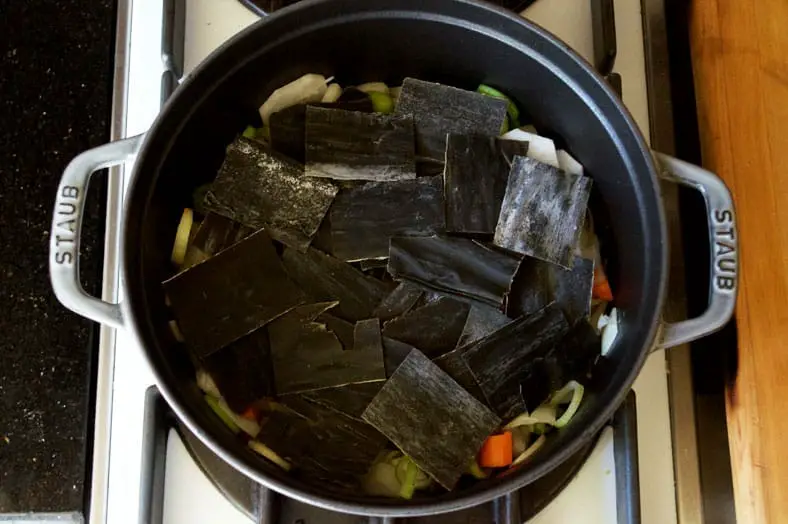
Regardless your meat of choice (or in our case, the lack thereof), you’ll bring your protein and some aromatic vegetables together in a stockpot filled with water. Bring the water to a boil before gently simmering it for up to an hour, after which point you’ll keep the meat and discard the vegetables.
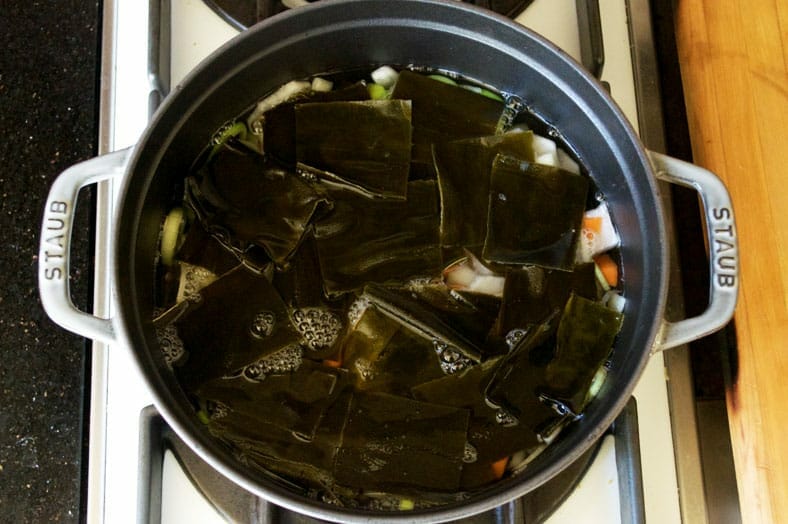
Making broth is a fairly hands-off process thankfully, since it gives you the chance to focus on the other key tteokguk component: the garaetteok.
Garaetteok: Cylindrical Stamped Rice Cakes
Whereas preparing broth is fairly simple, making your garaetteok – tteok meaning “rice cake”, and garae referring to its cylindrical shape – is a slightly more intricate process, especially if done in the traditional way.
In this recipe, you’ll see we take a slight shortcut to prepare these rice cakes in a more manageable way, but the longstanding way to prepare your dough for garaetteok is done in a steamer.
First things first, you need to create your dough for garaetteok. Take a mixing bowl full of rice flour and gradually pour and fold in very hot) water. Keep in mind that it might take some stirring to get the dough to the putty-like substance you need.
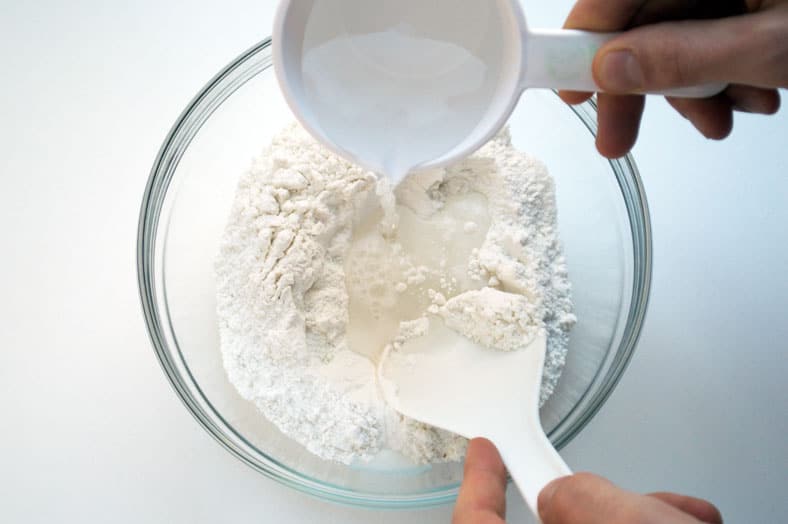


When you’ve got your putty in a more elastic, less sticky form, line your steamer with parchment paper and lay out your dough to steam for 25 minutes. Again, in our case, you’ll see we used a method that took a little less time.
After steaming, the dough will have developed a sort of elasticity to it. Lay it onto a flat surface coated with sesame oil. Especially given what’s ahead, a surface like a cutting board is probably the best tool to use here.

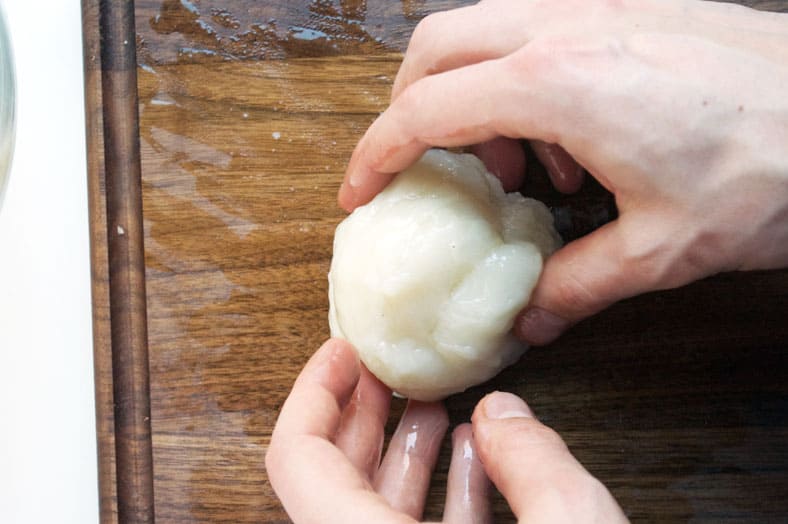
With your elastic garaetteok dough on the cutting board, you can first start by kneading the dough with your hands, but the real effect is done either with a pestle, the blunt side of a mallet, or any other type of tool you can hammer with. You’ll pound into the dough as much as you can to flatten and remove any clumps in the dough, and with repeated hammering, the dough will become even more elastic.
After you’ve hammered the dough thoroughly, rub some sesame oil into your hands and then roll the garaetteok into the shape of a cylinder by hand. At this point, if you think you’ll have extra, you can set some aside in the freezer for future use.
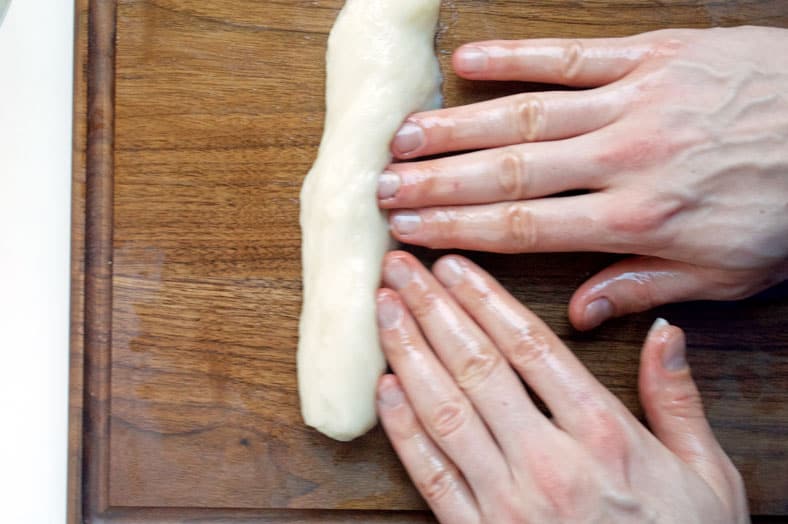
For the garaetteok you’ll have in your tteokguk, however, you’ll take a sharp knife and cut thin ovals out of your cylindrical log. Once you have a fair amount of oval rice cakes ready to go, it’s time for the last phase.

Bringing it All Together
Once your broth is ready to go, you’ll strain it and return only the liquid (and meats if you’re cooking with) back to the stockpot. Bring the broth to a gentle boil over medium heat, and add any additional aromatic ingredients you wish.
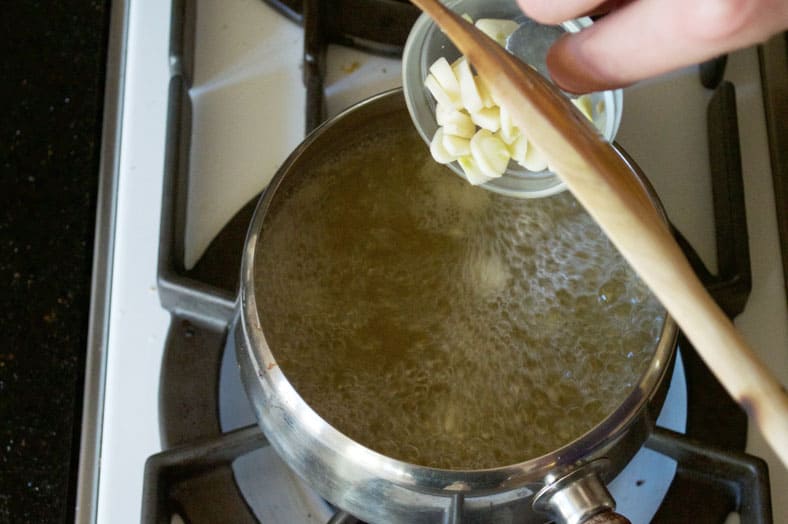
The final step is to submerge your garaetteok into the broth and to let them cook for several minutes. They’ll start out by sinking at the bottom, but they’ll signal they’re finished by floating and rising to the top.
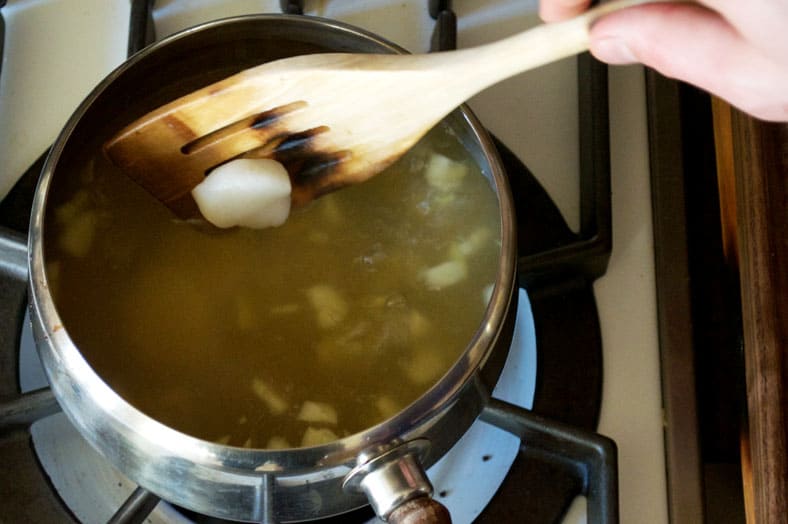
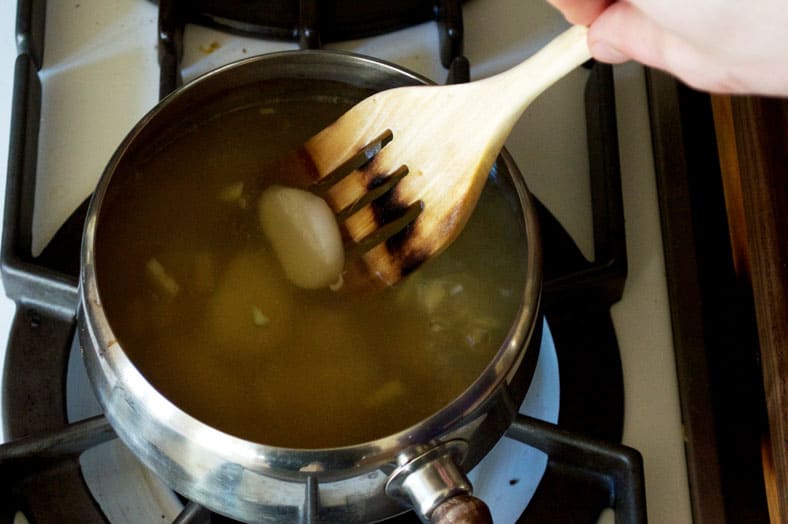
Take your entire stockpot off of the heat and ladle some tteokguk (with ample rice cakes) into a serving bowl. Depending on what you prefer, you can garnish your soup with anything from scallions to seaweed flakes to chili peppers. It’s really whatever you like!

Our Take on the Recipe
For a dish as flexible as tteokguk is, there was a whole wealth of recipes for us to choose from as our original reference. Despite this, we ended up starting with this recipe from HMart as our base. We source a lot of our lesser-known ingredients from this grocery store, so we felt this was a great way to pay homage to the store.
But as we alluded to earlier, one of our goals with tteokguk was to create a delicious vegan version of the soup for everyone to enjoy. This goal precluded us from using meat of any kind, and instead we had to add in a lot of vegetarian ingredients. The winning combination for us was dasima, or dried sea kelp (also called kombu in Japanese), that gave a great umami flavor to the broth. Combine the dasima with aromatic ingredients like leeks, carrots and onions, and you have yourself an outstanding broth.
When it came to making the garaetteok, we followed the lead of this recipe to create a “shortcut” version that takes a fraction of the time. Rather than using a steamer for ~20ish minutes, you can prepare similar homemade rice cakes by microwaving your covered bowl. We cut down the microwave cooking time by half with our version, which kept the rice flour dough slightly more elastic and less grainy. The overall end consistency is slightly different than the traditional version, but it’s definitely good enough for this tteokguk.
Finally, we made one extra addition to the tteokguk itself. As the broth was coming to a rolling boil, we added in a little soy sauce and sesame oil to give even more flavor to the base of the rice soup. At a teaspoon each, the amounts were modest, but they made a great addition nonetheless.
Otherwise, that’s pretty much it! Whether you choose to go with this vegan version or add some other meats into it, tteokguk is a fantastic.
How would you prepare your tteokguk? What garnishes would you have? Comment below!
